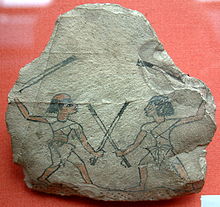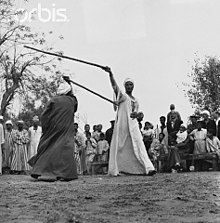Tahtib
| This article is part of a series on |
| Life in Egypt |
|---|
 |
| Culture |
| Society |
| Politics |
| Economy |
|
Egypt portal |

Tahtib (Egyptian Arabic: تحطيب, romanized: taḥṭīb) is the term for a traditional stick-fighting martial art[1] originally named fan a'nazaha wa-tahtib ("the art of being straight and honest through the use of stick").[2] The original martial version of tahtib later evolved into an Egyptian folk dance with a wooden stick.[3][4] It is commonly described in English as a "stick dance", "cane dance",[5] "stick-dancing game", or as ritual mock combat accompanied by music.[6] Nowadays, the word tahtib encompasses both martial practice and performance art. It is mainly practiced today in Upper Egypt. Tahtib is regularly performed for tourists in Luxor[7] and Aswan.[8]
The stick used in tahtib is about four feet in length and is called an asa, asaya, assaya, or nabboot. It is often flailed in large figure-eight patterns across the body with such speed that the displacement of air is loudly discernible.
History

The oldest traces of tahtib were found on engravings from the archaeological site of Abusir, an extensive necropolis of the Old Kingdom period, located in the south-western suburbs of Cairo. On some of the reliefs of the Pyramid of Sahure (V dynasty, c. 2500 BC);[9] the images and explanatory captions are particularly precise and accurate in their depiction of what seems to be military training using sticks. Tahtib, with archery and wrestling, was then among the three disciplines of warfare taught to soldiers.

Three of the 35 tombs of the Beni Hassan necropolis (XI-XII Dynasties, 1900 – 1700 BC) near the town of Minya,[10] contain engravings showing scenes of tahtib. Similar engravings can be seen in the archaeological site of Tell el Amarna (XVIII Dynasty, 1350 BC),[11] some 60 km south of Minya. In addition to its role as military training, tahtib matches were also popular among peasants and farmers. The first evidence of the festive representation of tahtib can only be seen in the New Empire (1500 – 1000 BC), as shown by the engravings on the walls of Luxor and Saqqâra[12] Early Christian writings mention tahtib as a leisure activity and a popular art performed by men during weddings and celebrations. It is believed that tahtib developed as a game or performance art in this civilian context.
Performance
As with its combative counterpart, the dance form of tahtib was originally performed by men, but female versions were later developed. In one form, the women dress as men and imitate the males. Another female variant is performed flirtatiously and with less aggression. The latter, called ra's el assaya (dance of the stick) is incorporated into cabaret or Raqs sharqi performances. The stick used for this dance is generally more lightweight and hooked at one end like a cane. It is often embellished with metallic-coloured foil or sequins. The costume is a simple baladi dress. Performances include balancing the cane on the head, hip or shoulder.
Music
Music in tahtib features the tabl (bass drum) and mizmar (folk oboe).[13] The right hand uses a heavier stick with a hooked head to beat out the dum (the deep sound from striking the center of the drum) which drive the heartbeat of the rhythm, while the left hand uses a light twig as a switch to produce rapid-fire staccato "taks" (the higher sound from striking the edge of the drum).
Modern tahtib
Modern tahtib[14] is an attempt to re-explore the sources of tahtib as a fighting art, and to enrich them as a martial practice[15][16] by codifying the techniques and teaching them structurally. As in traditional tahtib, the main target is the opponent's head, as it is considered the most fragile and vulnerable part of the body. Consequently, techniques revolve around protecting one's own head while reaching the head of the opponent. Victory can be attained either by a single clean touch to the head, or three touches to the body. Unlike its traditional counterpart, modern tahtib allows both women[17] and men to practice in mixed groups.[18]
See also
References
- ^ "Le tahtib, un Art martial égyptien pluri millénaire vivant". Egyptos.
- ^ "Tahtib". Akban Ninjutsu Academy.
- ^ "Tahtib and Egyptian Raqs al-Assaya: From Martial Art to Performing Art". www.shira.net.
- ^ "'Tahtib': The once martial art that turned into a dance". Retrieved 2018-05-08 – via DailyNews.
- ^ Michael B. Bakan, World music: traditions and transformations, McGraw-Hill, 2007, ISBN 978-0-07-241566-7, p. 279.
- ^ Biegman, Nicolaas H. (1990). Egypt: moulids, saints, sufis. Kegan Paul International. ISBN 9789061791225.
- ^ video Luxor Egyptian Stick Fighting (Tahtib) tourist exhibition
- ^ Lonely Planet (2009). The Cities Book: A Journey Through the Best Cities in the World. Lonely Planet. p. 54. ISBN 978-1-74179-887-6.
- ^ T. El Awady, ibid, VI.6.2, p. 208-210 ; D. Farout, Tahtib l’art de l’accomplissement et du bâton, ةgypte Afrique & Orient n° 60 (janvier 2011), p. 67-69.
- ^ P.E. Newberry, ' Beni Hassan, Vol. Part 1. London, England: Kegan Paul, Trench, Tubner & Co., Ltd., 1893.
- ^ Davies, N. de G. (1905). "The rock tombs of El-Amarna, Part II, Pl. 37-38, (reprinted 2004)" (PDF). Egypt Exploration Society. Retrieved 16 May 2021. ISBN 0-85698-160-5
- ^ W. Decker, Sports and games of Ancient Egypt, Yale, 1992, p. 83, pl. 52 ; J. A. Wilson, Ceremonial Games of the New Kingdom , JEA 17 (1931), p. 211-220
- ^ video Tahtib street performance on bass drum and Mizmar backstage
- ^ video 1st demo ever at Martial Arts Int'l Festival Paris 2010
- ^ Adel Paul Boulad, Modern tahtib : bâton de combat égyptien, Budo-Eds, 2014, ISBN 2846173389, p. 279., ISBN 978-2846173384
- ^ "Nevia". Archived from the original on July 15, 2014.
- ^ "Vidéo: Stage de Tahtib à l'Institut d'Etudes Politiques de Paris".
- ^ "Le tahtib, tout en bâton". May 16, 2014 – via Le Monde.
Further reading
- Beni Hasan (with plates) by Percy Newberry, et al.
- Beni Hasan - Archaeowiki.org
- N. de G. Davies's "Rock Tombs of El Amarna", in openlibrary.org
